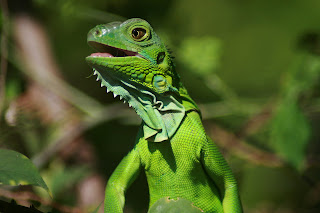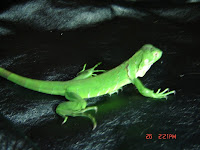Interesting Informations About The Baby Green Iguana
The green iguana is one kind of reptile which is commonly found all throughout South and Central America. The breeds of the green iguana are also spotted in Mexico, Paraguay, Brazil, and the Caribbean Islands. There is no definite proof that the green iguana ranks among the endangered animals but then it is sometimes misconstrued to be one because it is a major attraction to the hunters. Hunters love to capture the big female iguanas. The green iguana is also a favorite delicacy of some and it is known by the name of “Bamboo Chicken”.The Physical Appearance of the Green Iguana
The overly grown green iguanas typically grow in between four and six feet but there are some that extend up to seven feet. The tail takes up almost all of the length since it ranks to be almost half of the entire body measurement. Despite their being green, there is likewise the dominant black stripe coloring in its body. Not because they are called green iguanas they will already settle for the monochromatic color of green. The shade also diverts from the very bright green to the grayish and dull green. The skin of the green iguana is mostly rough primarily because of the pointy scales along the animal’s back. The green iguanas are equipped with claws and long fingers so that they can easily grasp and climb.
The Habitat of the Green Iguana
Baby green iguanas are typically raised in the tropical rainforest areas specifically in areas with lower altitudes and accessible water resources like those of the streams and rivers. Most of their formative years are confined in the forest top at about forty up to fifty feet high atop the ground.
The Admirable Adaptations of the Baby Green Iguanas
Aside from the invariable claws and long fingers possessed by the baby green iguanas, they also have a lot of proficient and admirable adaptations with them. The baby green iguanas are keen in terms of their senses of hearing, sight, and smell. One of their defense mechanisms is their tail which is obviously sharp and is snapped high into the air when danger is sensed. Once a predator gets the chance to grab the tail, it grows again without any damage at all. The skin of the baby green iguana is tough—it is able to avoid scratches, cuts, and is also water-resistant. The pigmentation on the skin of the baby green iguana helps out in the camouflaging especially when there are predators in the area. But then when their predators detect them, the baby green iguanas are able to swiftly jump from the trees and then dive directly into the water. Mind you, they are excellent swimmers.
Apart from these excellent adaptations, the baby green iguanas are also strong. Imagine that they do fall off the ground at about 40 up to 50 feet but they still manage to come unhurt. The male green iguanas have what is known as the dewlap on their skins. This is the special flap on their skins which they use to impress the female green iguanas or to intimidate their oncoming predators. With these dewlaps, they manage to let themselves appear bigger. Another excellent characteristic for the green iguanas is that they are able to keep fat under their own necks and jaws for quite a time especially when there is not much of the food at hand.




